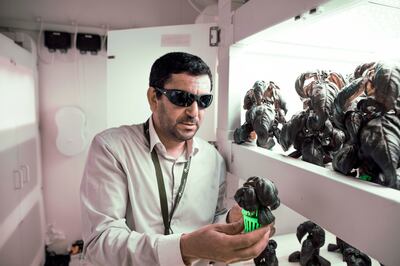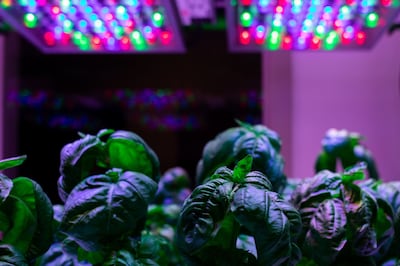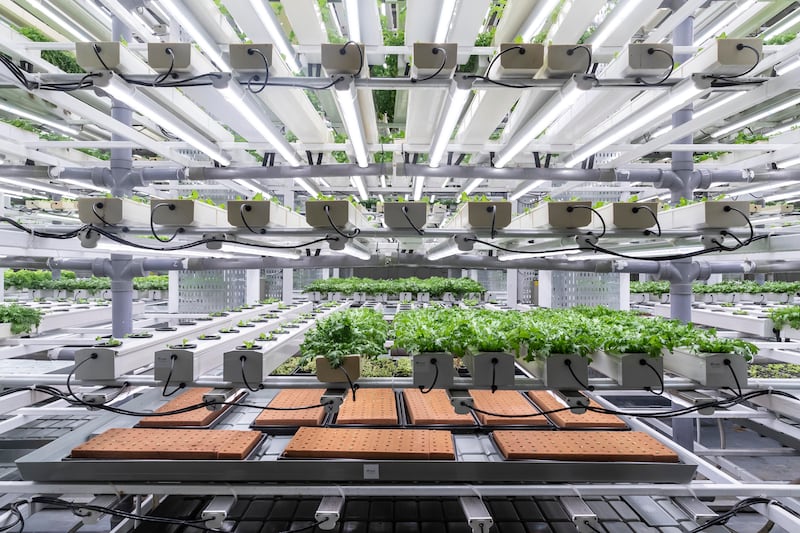As the world’s population grows – the UN forecasts that it will exceed 10 billion by 2100 – new ways to increase food production are being sought.
This is illustrated by the rise of vertical farming, which involves crops being grown in layers in an indoor environment.
Eye-catching examples have hit the news in recent years, such as Pasona Urban Farm in a multi-storey office block in Japan.
Meanwhile, researchers have suggested that some of the world’s thousands of abandoned mines could be repurposed as farms.
But is this brave new world of agriculture really part of the answer to global food security issues – or is it suitable only for producing salad vegetables, strawberries and a small number of other crops?
What is vertical farming and what are its advantages and disadvantages?
Vertical farming involves growing crops in layers one on top of the other in systems where light is provided by LED bulbs instead of the sun, and humidity and temperature are controlled. Depending upon the climate where the farm is located, heating or cooling may be required.
Dr Hail Rihan, of the University of Plymouth in the UK, prefers the term controlled environment agricultural systems to reflect the fact that the plants are grown indoors in strictly managed conditions.
Key advantages include there being higher yields for a given ground area, sometimes many times those of outdoor or greenhouse agriculture.
As conditions are precisely controlled, crops can be grown year round, eliminating seasonal shortages, and in almost any location. The controlled conditions also make it harder for pests to become established.
Often vertical farming is associated with hydroponic systems, in which the plant is grown in a nutrient solution rather than soil. This may reduce water use by as much as 90 per cent compared to traditional growing.

However, controlled environment agriculture requires significant investment in buildings and equipment, and has high running costs.
If the electricity for the lighting and heating or cooling comes from burning fossil fuels, vertical farming can have a much higher carbon footprint than traditional agriculture, in which plants take energy from the sun rather than LED bulbs.
Higher costs explain why vertical farming and other controlled environment systems are used for a relatively narrow range of crops, including leafy green vegetables such as lettuces and basil, fruits including strawberries and mushrooms. Multiple crops of these can be produced in a year, offsetting high running costs.
Dr Rihan, who has been involved with multiple projects, including several in Saudi Arabia, is confident that vertical farming will be rolled out much more widely in future.
“It became commercially applicable, even for leafy greens, [only] in the last three to four years. The technology is developing very fast,” he said.
“Very soon the technology will be applied for a wide range of crops.”
One study estimated that the industry would be worth around $3 billion this year.
Can vertical farming compete with other forms of agriculture?
Prof Carl-Otto Ottosen, who researches plant growth and agriculture at Aarhus University in Denmark, said that in his home country and other parts of northern Europe, vertical farming was often not competitive because of its high energy use.
Small crops often produced in vertical farming can, he said, be grown equally well in his region in a greenhouse where environmental conditions are controlled.
He questioned the economic viability of vertical farming in his country.
“From a Danish point of view, you cannot produce anything now and make money from it,” he said.
“You don’t get the payback. Very few people would pay £5 (Dh23) for a white cabbage here in northern Europe.”
There have been missteps in the industry, with a number of vertical farming companies having been declared bankrupt or forced to downsize amid financial woes.
Prof Ottosen said that there might be a better case for vertical farming in places such as Singapore, where land is at a premium.
Indeed the South-East Asian city state has multiple vertical farms, tying in with its aim of producing 30 per cent of its nutritional needs by 2030.
Several other Asian countries, including China, Japan, South Korea and Thailand, also have vertical farms, as does the US.
There have also been major investments in vertical farming in the Middle East, including the UAE, where traditional agriculture faces extreme temperatures and water stress.

Extreme temperatures mean high energy demands for cooling, but if the power comes from solar energy, costs and carbon emissions can be defrayed.
Also, controlled environment agriculture or vertical farming may have an advantage in very hot climates, Dr Rihan said, because buildings can be insulated, so cooling is possible. Cooling a greenhouse is much more difficult, he said, because of the lack of insulation.
It may also become more useful as some areas become less suitable for traditional agriculture as a result of climate change.
“In Europe, the supply chain is being challenged from Spain and Morocco because of weather conditions – limited water and high temperatures,” Prof Ottosen said.
Greenhouse producers in northern Europe are, he said, expanding their production to cope with these supply chain difficulties, although vertical farms could be another alternative source of produce.
Controlled environment agriculture systems, including vertical farming, may become increasingly competitive because, for example, LED lighting – the technology that made vertical farming possible in the first place – is becoming more efficient.
The automation technology, including robotics and software, that vertical farming relies upon is also advancing.
Will vertical farming replace traditional farming?
While enthusiasts for vertical farming hope that its methods will become applicable to a wider range of crops, there are plants for which traditional methods will almost certainly remain most suitable.
Maize, one of the most important crops globally, with annual production of about 400 million tonnes in the US alone, is an example.
It grows to about two to three metres tall, which means that it is not feasible to have multiple crops above one another.
If just a single layer of maize is grown, indoor production in a controlled environment with LED bulbs to provide light and a controlled temperature is uneconomic.
However, there are crops not currently grown vertically that may become more suited to controlled environment agriculture thanks to scientists.
Wheat is not ideally suited to controlled environment agriculture because it requires much higher light intensity – and so higher costs – than lettuce and other leafy green vegetables, and the growing cycle is longer at six to seven months.
However, Dr Rihan said that researchers have been able to shorten the seed-to-seed growth cycle to as little as two months, which would allow multiple crops to be grown and harvested each year.
Furthermore, advances in plant breeding are leading to the development of varieties suited to indoor cultivation, so he envisages a future where the techniques will be used with crops like wheat.







